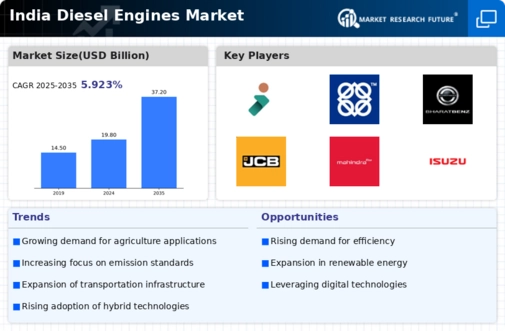Agricultural Mechanization
Agricultural mechanization is a vital driver for the diesel engines market in India. The country's agricultural sector, which employs nearly 42% of the workforce, is increasingly adopting mechanized solutions to enhance productivity. Diesel engines are preferred for tractors and other agricultural machinery due to their efficiency and reliability. The government has introduced various schemes to promote mechanization, such as the Sub-Mission on Agricultural Mechanization, which aims to provide financial assistance to farmers. This initiative is expected to increase the penetration of diesel engines in the agricultural sector, potentially leading to a market growth rate of around 8% annually. As farmers seek to improve yields and reduce labor costs, the diesel engines market is expected to see sustained demand.
Infrastructure Development
The ongoing infrastructure development in India plays a crucial role in driving the diesel engines market. With the government's focus on enhancing roadways, railways, and ports, the demand for heavy-duty vehicles equipped with diesel engines is likely to increase. The National Infrastructure Pipeline aims to invest approximately $1.4 trillion in infrastructure projects by 2025, which could significantly boost the diesel engines market. Additionally, the construction and logistics sectors, which heavily rely on diesel-powered machinery and vehicles, are expected to expand, further propelling market growth. As these sectors grow, the diesel engines market will benefit from increased sales and production, indicating a robust future for diesel engine manufacturers in India.
Energy Security Initiatives
Energy security initiatives in India are influencing the diesel engines market positively. The government is focusing on reducing dependence on imported fuels and enhancing domestic energy production. Diesel engines, known for their efficiency and reliability, are integral to various sectors, including transportation, agriculture, and construction. The push for energy security may lead to increased investments in diesel engine technology, ensuring compliance with stringent emission norms while maintaining performance. Furthermore, the government's initiatives to promote biofuels and alternative energy sources could complement the diesel engines market, as hybrid systems become more prevalent. This dual approach may enhance the market's resilience and adaptability in the face of evolving energy policies.
Urbanization and Population Growth
Urbanization and population growth in India are driving the diesel engines market significantly. As cities expand and populations increase, the demand for transportation and construction equipment rises correspondingly. The urban population is expected to reach 600 million by 2031, leading to heightened demand for commercial vehicles and machinery powered by diesel engines. This trend is particularly evident in metropolitan areas, where infrastructure development is crucial to accommodate growing populations. The diesel engines market is likely to benefit from this urban expansion, as more vehicles and machinery are required to support urban infrastructure projects. Consequently, manufacturers may experience increased demand for diesel engines, reflecting the broader trends of urbanization and economic development.
Transportation and Logistics Growth
The rapid growth of the transportation and logistics sector in India is a significant driver for the diesel engines market. With the rise of e-commerce and the need for efficient supply chain solutions, the demand for commercial vehicles powered by diesel engines is on the rise. According to the Ministry of Road Transport and Highways, the freight traffic in India is projected to grow at a CAGR of 7.5% from 2020 to 2025. This growth is likely to result in increased sales of diesel-powered trucks and vans, which are favored for their fuel efficiency and long-range capabilities. Consequently, the diesel engines market is expected to benefit from this trend, as logistics companies invest in expanding their fleets to meet growing consumer demands.




















Leave a Comment